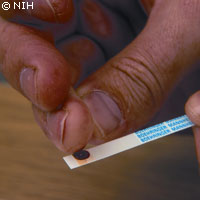Computational modelling allows insights into cell membrane fusion
Researchers from France, the UK and Austria have modelled the SNARE protein complex that acts as a catalyst in the fusion of two membranes, using the processing power of the Distributed European Infrastructure for Supercomputing Applications (DEISA). They hope to open up new opportunities for pharmaceutical development. 'Basic research is essential, since there are several aspects concerning the functioning of proteins and cell membranes that are not yet fully understood. A better understanding of these mechanisms will facilitate, for example, the development of new pharmaceutical agents,' explains Dr Marc Baaden, researcher at the Laboratory of Theoretical Biochemistry in Paris. 'By examining a phenomenon at the atomic level, we can gain insight into the behaviour of cell membranes and proteins in general and on a larger scale.' Many diseases are associated with functional disorders of the cell membranes. In the case studied by Dr Baaden and his colleagues, the cell membranes either do not fuse at all or fuse too heavily. The SNARE protein complex is responsible for this fusion. Disturbed functioning of the SNARE proteins may result in adult-onset diabetes, for example. Hence, understanding the SNARE function may facilitate development of new therapeutic treatments. Apart from medical science, the cosmetics industry and nanotechnology will benefit from a better understanding of protein functioning. 'Knowledge of the functioning of cell membranes will open up opportunities in the field of nanotechnology as well. In technical terms, the proteins we study are clever machines that perform their intended tasks excellently, that is, to fuse two lipid membranes firmly together,' Dr Baaden points out. While researchers frequently have to resort to pen and paper when describing events at molecule level - a technique that Dr Baaden dubs 'cartoon biology' and criticises for being easily misleading - the scientists involved in this study had been granted access to the DEISA network in the framework of the DEISA Extreme Computing Initiative (DECI), enabling them to develop am exceptionally complex model. 'Computational molecular modelling, or simulation, takes the physical properties into account in a more realistic manner,' Dr Baaden states. 'A good molecular model enables us to examine the smallest details of the system in a controlled fashion and under the desired circumstances. We can also easily change any of the properties of the model to test different hypotheses.' As a result, simulation facilitates the examination of dynamic events. 'Traditionally, computational modelling has been applied to simulate a single membrane - this is already a very challenging task. We, however, simulated two lipid membranes held together by a protein complex, so our challenge was even greater,' Dr Baaden says. For him, in the future, computational modelling methods will have to combine highly accurate atomic level modelling with coarse-grained models simulating a more extensive event. In addition, 'communication between the simulations on various levels is important. This will allow us to simulate a detail of particular significance more accurately, and larger entities by means of a coarse-grained model,' Dr Baaden concludes.



